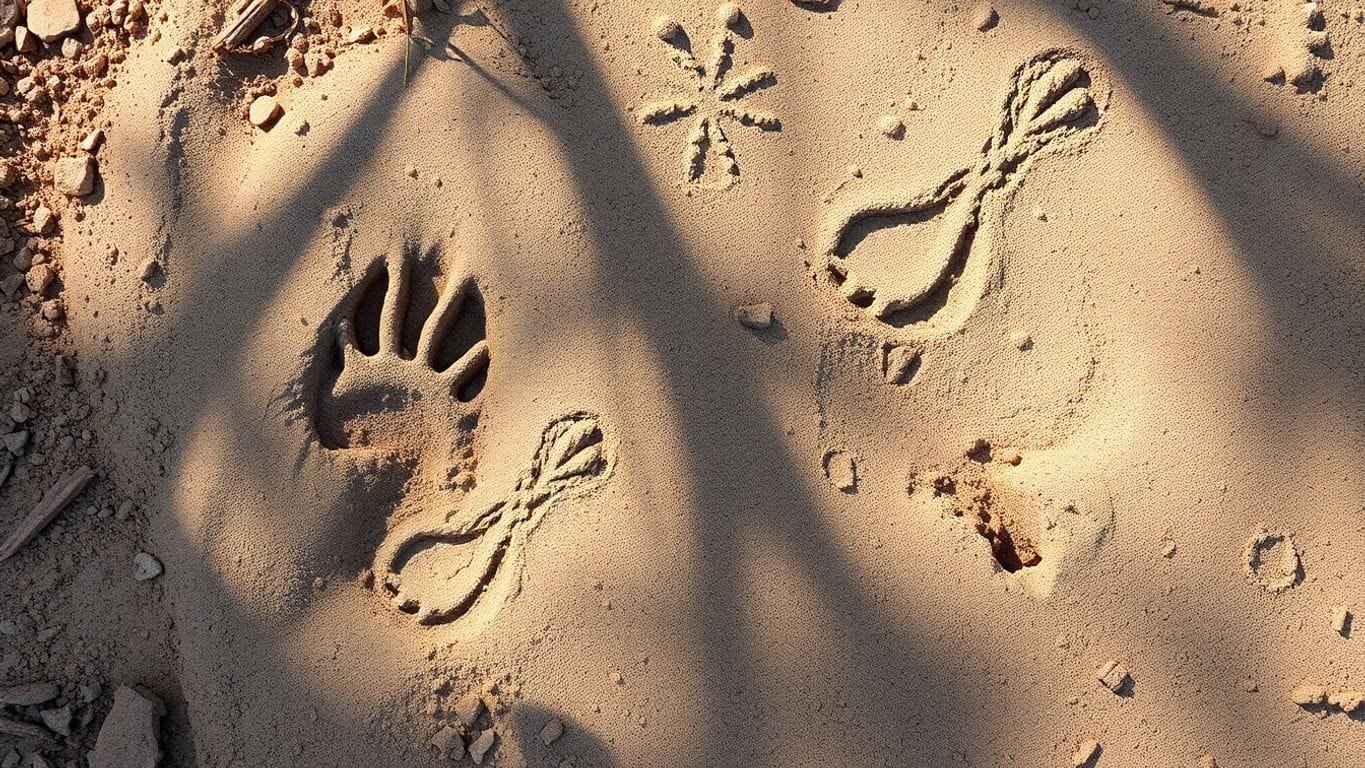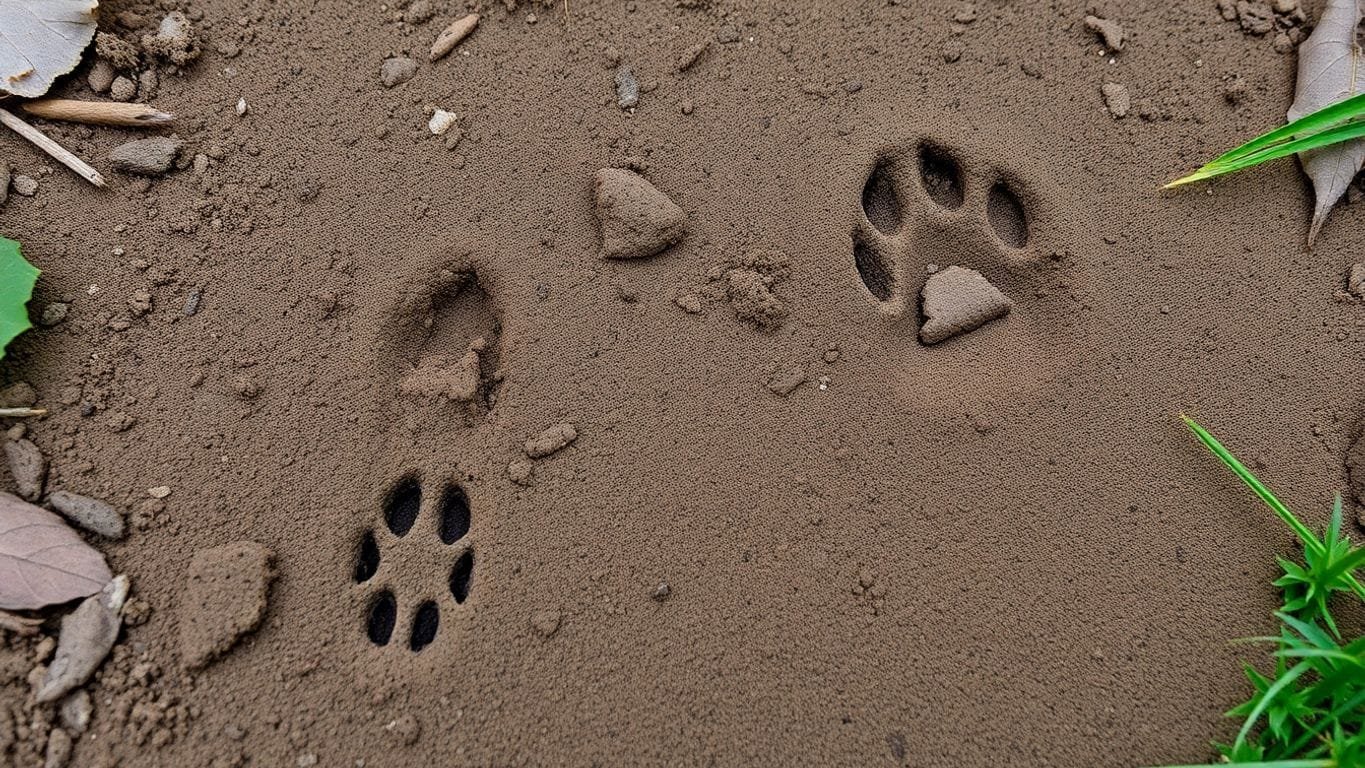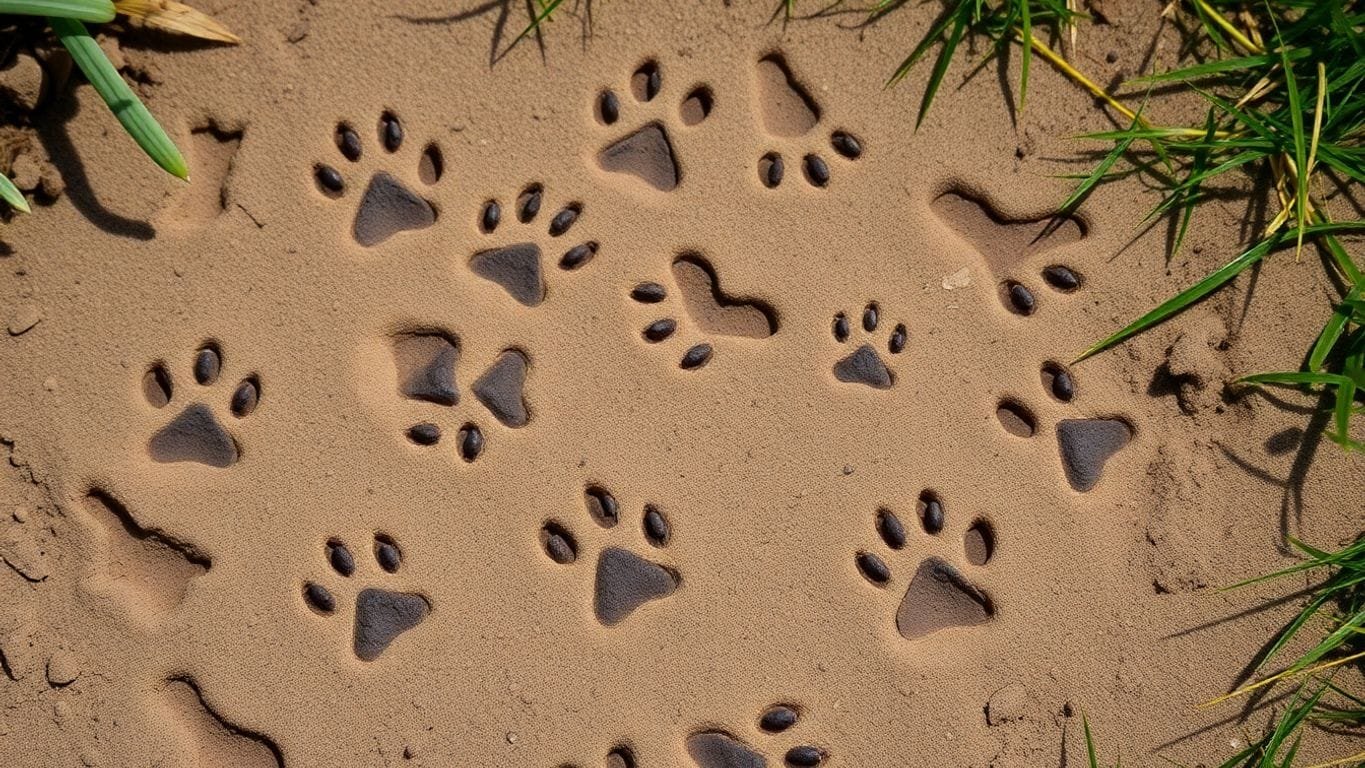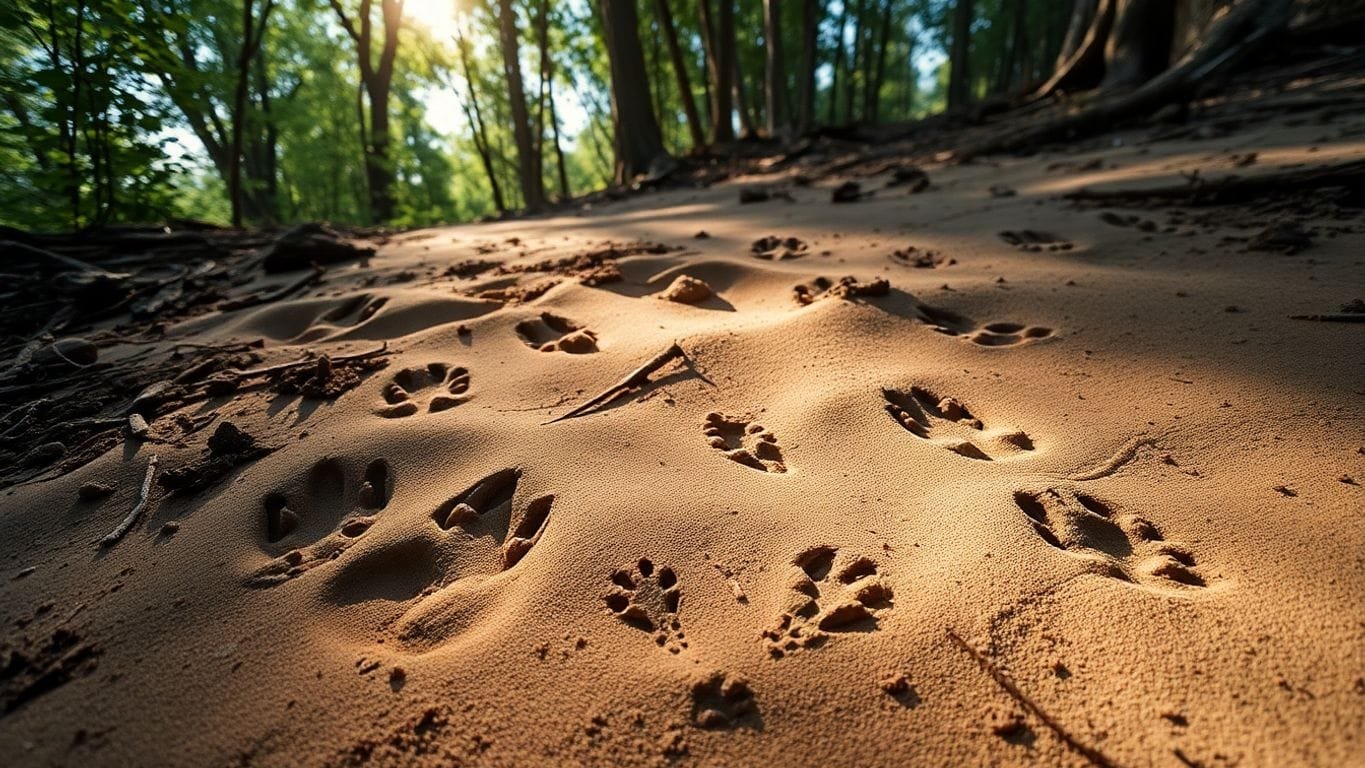Animal tracking is an exciting way to connect with nature and understand the wildlife around us.
By learning to identify the tracks of different animals, we can gain insights into their behavior, habits, and the ecosystems they inhabit.
This guide will help you distinguish between predator and prey tracks, providing you with the knowledge to explore the great outdoors with confidence.
Key Takeaways about Identifying Predator vs. Prey Tracks
- Understanding animal tracks helps us learn about wildlife behavior.
- Predator tracks are usually larger and have distinct claw marks.
- Prey tracks are often smaller and show signs of lighter movement.
- Different terrains affect how tracks are preserved and seen.
- Using technology can enhance your tracking skills and safety.
Understanding the Basics of Animal Tracking

Why Track Animals?
Tracking animals is not just a hobby; it’s a way to connect with nature.
By observing tracks, we can learn about the behaviors and habits of wildlife.
Whether we’re looking for signs of a predator or just curious about who’s been wandering through our backyard, tracking opens up a whole new world.
Here are a few reasons why we might want to track animals:
- Discover who’s been in the area
- Understand animal behavior
- Connect with nature on a deeper level
Essential Tools for Tracking
To get started with tracking, we need some basic tools.
Here’s a quick list of what we should have:
- A good pair of binoculars
- A notebook for observations
- A camera to capture tracks and signs
- A field guide to help identify species
Reading the Landscape
Understanding the landscape is crucial for effective tracking. We should pay attention to:
- Natural paths where animals might travel
- Areas with signs of feeding, like nibbled plants
- Water sources that attract wildlife
Tracking animals is the art of interpreting signs like footprints, natural paths, and nibbled plants to discover who has recently been foraging, hunting, or just passing through.
By learning these basics, we can enhance our tracking skills and enjoy the great outdoors even more!
Key Differences Between Predator and Prey Tracks

When we’re out in the wild, spotting animal tracks can be super exciting!
But did you know that there are some key differences between predator and prey tracks?
Understanding these differences can help us better appreciate the wildlife around us.
Track Shape and Size
- Predator tracks are usually larger and more elongated.
- They often have a more defined shape, like a dog or cat paw.
- Prey tracks, on the other hand, tend to be smaller and rounder, like those of deer or rabbits.
| Type of Track | Shape | Size |
|---|---|---|
| Predator | Elongated | Larger |
| Prey | Round | Smaller |
Stride Patterns
- Predators often have longer strides as they chase their prey.
- This means their tracks will be spaced further apart.
- Prey animals usually have shorter strides, as they tend to be more cautious and quick on their feet.
Claw Marks and Impressions
- One of the easiest ways to tell predator tracks from prey tracks is by looking for claw marks.
- Predators like wolves and cats will leave distinct claw impressions.
- Prey animals, like deer, typically don’t have visible claw marks, as their hooves are more rounded and smooth.
By learning to identify these differences, we can enhance our outdoor adventures and connect more deeply with nature.
So, next time we’re out tracking, let’s keep an eye out for these details! They can tell us a lot about the animals that roam the wild.
Identifying Common Predator Tracks
When we’re out in the wild, spotting predator tracks can be super exciting!
Understanding these tracks helps us connect with nature and learn more about the animals around us. Let’s dive into some common predator tracks we might encounter.
Canine Tracks: Wolves and Coyotes
Canine tracks are often easy to spot.
Here are some key features:
- Shape: Usually oval or round.
- Size: Can vary, but wolf tracks are larger than coyote tracks.
- Claw Marks: You might see claw marks, but they’re often less pronounced than in felines.
| Animal | Track Size (inches) | Claw Marks Visible |
|---|---|---|
| Wolf | 4-5 | Yes |
| Coyote | 2-3 | Sometimes |
Feline Tracks: Bobcats and Mountain Lions
Feline tracks can be a bit trickier.
Here’s what to look for:
- Shape: More rounded than canine tracks.
- Size: Mountain lion tracks are significantly larger than bobcat tracks.
- Claw Marks: Usually no claw marks visible, as they retract their claws.
Bear Tracks: Grizzlies and Black Bears
Bear tracks are massive and unmistakable.
Here’s how to identify them:
- Shape: Large and rounded.
- Size: Can be up to 10 inches long for grizzlies.
- Claw Marks: Claw marks are often visible, especially in soft ground.
Remember, tracking is not just about finding footprints; it’s about understanding the story behind them. Each track tells us where the animal has been and what it might have been doing!
Identifying Common Prey Tracks

When we’re out in the wild, spotting prey tracks can be super exciting!
Knowing how to identify these tracks helps us understand the animals around us.
Let’s dive into some common prey tracks we might encounter.
Deer Tracks: Whitetail and Mule Deer
Deer tracks are often among the easiest to spot.
Here’s what to look for:
- Shape: Heart-shaped or oval
- Size: About 2-3 inches long
- Impressions: Usually show two distinct toes
Rabbit and Hare Tracks
Rabbits and hares leave behind tracks that can be tricky to differentiate:
- Shape: Round with a noticeable gap between the front and back feet
- Size: Front tracks are about 2-3 inches, back tracks are larger
- Impressions: Often show a hopping pattern
Rodent Tracks: Squirrels and Chipmunks
Rodents are everywhere, and their tracks can be quite small:
- Shape: Tiny, with four toes on each foot
- Size: Less than an inch long
- Impressions: Look for small clusters of tracks, often near food sources
| Animal Type | Track Size | Distinct Features |
|---|---|---|
| Deer | 2-3 inches | Heart-shaped |
| Rabbit | 2-3 inches | Round, hopping |
| Rodent | <1 inch | Four toes |
Understanding these tracks not only enhances our tracking skills but also deepens our connection with nature.
By learning to identify these common prey tracks, we can better appreciate the wildlife around us.
So, next time we’re out exploring, let’s keep our eyes peeled for these signs of life!
Interpreting Track Patterns and Behaviors
Gait Analysis
When we’re out tracking, one of the coolest things we can do is analyze the gait of the animal.
This helps us understand how it moves and what it might be doing.
Here are some key points to consider:
- Track spacing: The distance between tracks can tell us if the animal is walking, trotting, or running.
- Track depth: Deeper tracks usually mean the animal is heavier or moving faster.
- Direction of tracks: Following the direction can lead us to where the animal is headed.
Track Aging Techniques
Knowing how to age tracks can give us insights into the animal’s behavior.
Here’s how we can do it:
- Fresh tracks: Look for clear edges and no debris.
- Old tracks: Edges may be worn down, and dirt might have filled in.
- Very old tracks: They may be hard to see and covered with leaves or dirt.
Behavioral Clues from Tracks
Tracks can tell us a lot about what the animal was doing.
For example:
- Predator tracks often show signs of stalking or pouncing.
- Prey tracks might indicate fleeing or grazing.
- Group tracks can suggest social behavior, like animals moving together.
Understanding these patterns helps us connect with nature and appreciate the dance of life happening all around us.
By paying attention to these details, we can become better trackers and deepen our understanding of the wildlife around us. Let’s keep exploring!
Scat and Other Signs: Complementing Track Identification
When we’re out in the wild, tracking animals isn’t just about footprints.
Scat and other signs can tell us a lot about the animals nearby.
Here’s how we can use these clues to enhance our tracking skills:
Identifying Scat
- Shape and Size: Different animals leave scat of various shapes and sizes.
- For example, deer scat is usually small and pellet-like, while bear scat can be large and messy.
- Content: What’s in the scat can give us hints about the animal’s diet. If we see berries or fur, we might be looking at bear scat.
- Location: Where we find the scat can also be telling. If it’s near a water source, it might belong to a deer or other prey animals.
Recognizing Feeding Signs
- Chewed Plants: Look for plants that have been nibbled on. This can indicate the presence of herbivores like rabbits or deer.
- Digging: Holes in the ground can show where animals like squirrels or raccoons have been searching for food.
- Scratches on Trees: These can indicate that a bear or a cat has been marking its territory or looking for food.
Understanding Territorial Markings
- Urine and Scratches: Many animals, especially predators, will mark their territory with urine or scratches on trees. This can help us identify which animals are nearby.
- Tracks and Scat Together: When we find both tracks and scat, we can get a clearer picture of the animal’s behavior and movements.
By paying attention to scat and other signs, we can become better trackers and understand the wildlife around us more deeply.
In summary, tracking isn’t just about footprints; it’s about piecing together a story from various signs in nature. Let’s keep our eyes peeled for these clues next time we’re out exploring!
Tracking in Different Terrains and Weather Conditions
When we head out to track animals, we need to remember that different terrains and weather can change everything. Understanding these factors can make us better trackers!
Tracking in Snow
- Snow can be a great canvas for tracks. The contrast makes it easier to spot prints.
- Look for the depth of the tracks; deeper prints often mean heavier animals.
- Pay attention to the direction of the tracks; they can tell us where the animal is headed.
Tracking in Mud and Wetlands
- Muddy areas can show us a lot about animal behavior.
- Soft ground captures details like claw marks and stride length.
- Be careful! Wet conditions can make tracking tricky, as tracks can wash away quickly.
- Use a track chart to help identify prints, especially in these conditions.
Tracking in Forests and Grasslands
- In dense forests, look for broken twigs or disturbed leaves as clues.
- In open grasslands, tracks may be less visible, but you can often find signs of feeding or bedding areas.
- Always keep an eye out for scat; it can provide valuable information about what animals are nearby.
Remember, tracking is not just about finding prints; it’s about piecing together a story of the wildlife around us!
Using Technology to Aid in Tracking
When it comes to tracking animals, technology can be our best friend.
From GPS devices to mobile apps, we have a lot of tools at our disposal that can make tracking easier and more accurate.
Here’s how we can use these technologies effectively:
GPS and Mapping Tools
- Precision: GPS devices help us pinpoint exact locations where tracks are found.
- Mapping: We can create detailed maps of our tracking routes, making it easier to revisit areas.
- Data Collection: These tools allow us to collect data over time, helping us understand animal movements better.
Trail Cameras and Drones
- Remote Monitoring: Trail cameras let us capture images of animals without being present, giving us insights into their behavior.
- Drones: Drones can cover large areas quickly, helping us spot tracks or animals from above.
- Real-Time Data: Some drones can provide live feeds, allowing us to track movements as they happen.
Mobile Apps for Track Identification
- Instant Identification: Apps can help us identify tracks on the spot, making tracking more interactive.
- Community Sharing: Many apps allow users to share their findings, creating a community of trackers.
- Learning Resources: These apps often include guides and tips, helping us improve our tracking skills.
Using technology not only enhances our tracking experience but also deepens our connection with nature. It’s like having a superpower that helps us understand the wild better!
In summary, integrating technology into our tracking adventures can make a huge difference.
Whether we’re using GPS, cameras, or apps, these tools help us become better trackers and appreciate wildlife even more. Let’s embrace these innovations and see where they take us!
Safety Tips for Tracking Predators
When we head out to track animals, especially predators, we need to keep our safety in mind.
Staying aware of our surroundings is key! Here are some tips to help us stay safe:
Recognizing Dangerous Situations
- Know the area: Familiarize ourselves with the wildlife in the region. Understanding what predators are nearby can help us prepare.
- Stay alert: Keep an eye out for signs of predators, like fresh tracks or scat. If we see these, it might be time to rethink our location.
- Travel in groups: There’s safety in numbers! It’s always better to track with friends or family.
What to Do if You Encounter a Predator
- Stay calm: Don’t panic. Most predators want to avoid us as much as we want to avoid them.
- Make noise: Speak loudly and firmly to let the animal know we’re there. This can often scare them off.
- Back away slowly: If the predator doesn’t leave, we should slowly back away without turning our backs on it.
First Aid for Tracking Injuries
- Carry a first aid kit: Always have a basic first aid kit with us. It should include band-aids, antiseptic wipes, and any personal medications.
- Know basic first aid: Familiarize ourselves with how to treat common injuries like cuts or sprains.
- Have a plan: If someone gets hurt, we should know the quickest way to get help.
Remember, tracking can be an amazing adventure, but we must prioritize our safety. By being prepared and aware, we can enjoy the wild while keeping ourselves safe from potential dangers.
In summary, tracking predators can be thrilling, but we need to be smart about it. Let’s keep these tips in mind to ensure a safe and enjoyable experience!
Ethical Considerations in Tracking Wildlife
When we head out to track animals, it’s super important to think about our impact on nature.
Respecting wildlife and their habitats should always be our top priority. Here are some key points to keep in mind:
Respecting Wildlife and Their Habitats
- Keep a safe distance: We should always observe animals from afar to avoid stressing them out.
- Stay on trails: This helps protect the plants and animals that call these areas home.
- Leave no trace: Whatever we bring in, we should take out. This keeps nature clean and safe for everyone.
Leave No Trace Principles
- Plan ahead: Knowing where we’re going helps minimize our impact.
- Travel lightly: The less we carry, the less we disturb.
- Respect wildlife: Observing from a distance is key to keeping animals safe.
Legal Aspects of Tracking
- Know the rules: Different areas have different laws about tracking and wildlife observation. It’s our responsibility to be informed.
- Permits may be required: Some places need special permissions for tracking activities.
Tracking is not just about finding footprints; it’s about understanding and respecting the creatures we share this planet with.
By following these guidelines, we can enjoy tracking while ensuring that we protect the wildlife and their environments. Let’s be responsible trackers and make a positive impact!
Learning from Experienced Trackers

Books and Field Guides
When we dive into the world of tracking, there’s a treasure trove of books and guides that can really help us sharpen our skills. Here are some must-reads:
- The Complete Tracker by Len McDougall: This book is a fantastic resource for understanding the tracks and signs of North America’s wildlife. It’s like having a master tracker guiding us through the wilderness.
- Tom Brown’s Field Guide: This guide teaches us the ancient skills of tracking and nature observation. It’s packed with tips that can help us become more aware of our surroundings.
- Scats and Tracks of the Pacific Coast by James Halfpenny: This one helps us identify various species by their tracks and droppings, making it easier to understand who’s been in the area.
Workshops and Courses
Nothing beats hands-on experience! Participating in workshops and courses can be a game-changer.
Here’s what we can look for:
- Local Nature Centers: Many offer tracking workshops that are perfect for beginners.
- Wildlife Organizations: They often host courses led by experienced trackers.
- Online Classes: If we can’t find local options, there are plenty of online resources available.
Joining Tracking Communities
Being part of a community can really enhance our learning experience. Here’s how we can connect:
- Social Media Groups: There are many groups dedicated to tracking where we can share tips and experiences.
- Local Clubs: Joining a local wildlife or tracking club can provide us with opportunities to learn from others.
- Meetup Events: Look for events in our area where we can meet fellow trackers and share knowledge.
Learning from others is one of the best ways to grow our skills. Whether it’s through books, workshops, or community, we can always find new ways to improve our tracking abilities.
In the end, tracking is not just about identifying tracks; it’s about connecting with nature and understanding the stories it tells us. Let’s get out there and start tracking!
Wrapping It Up: Understanding Tracks in Nature
Knowing how to tell predator tracks from prey tracks can really change your outdoor adventures.
Whether you’re hiking, camping, or just exploring your backyard, spotting these signs helps you connect with nature in a whole new way.
Remember, every track tells a story about the animal that made it. So next time you’re out, keep your eyes peeled and your mind open. You never know what you might discover!
Frequently Asked Questions
What is animal tracking?
Animal tracking is the practice of observing and identifying the footprints and signs left by animals in their natural environment.
Why is it important to track animals?
Tracking animals helps us understand their behavior, habits, and habitats, which is useful for conservation and wildlife management.
What tools do I need for tracking?
You typically need a good pair of binoculars, a field guide on animal tracks, a notebook for observations, and sometimes a camera.
How can I tell if a track is from a predator or prey?
Predator tracks are usually larger and have distinct claw marks, while prey tracks are smaller and often show more rounded shapes.
What should I do if I find tracks in my yard?
Observe the tracks carefully and try to identify the animal. If it’s a predator, ensure your pets are safe and consider contacting local wildlife experts.
Can I track animals in any weather?
Yes, but certain conditions like snow or mud make tracking easier because tracks are more visible.
Is tracking animals safe?
Yes, but always be aware of your surroundings, especially if tracking in areas known for predators.
How can I learn more about animal tracking?
You can read books, attend workshops, or join local wildlife tracking groups to improve your skills.


